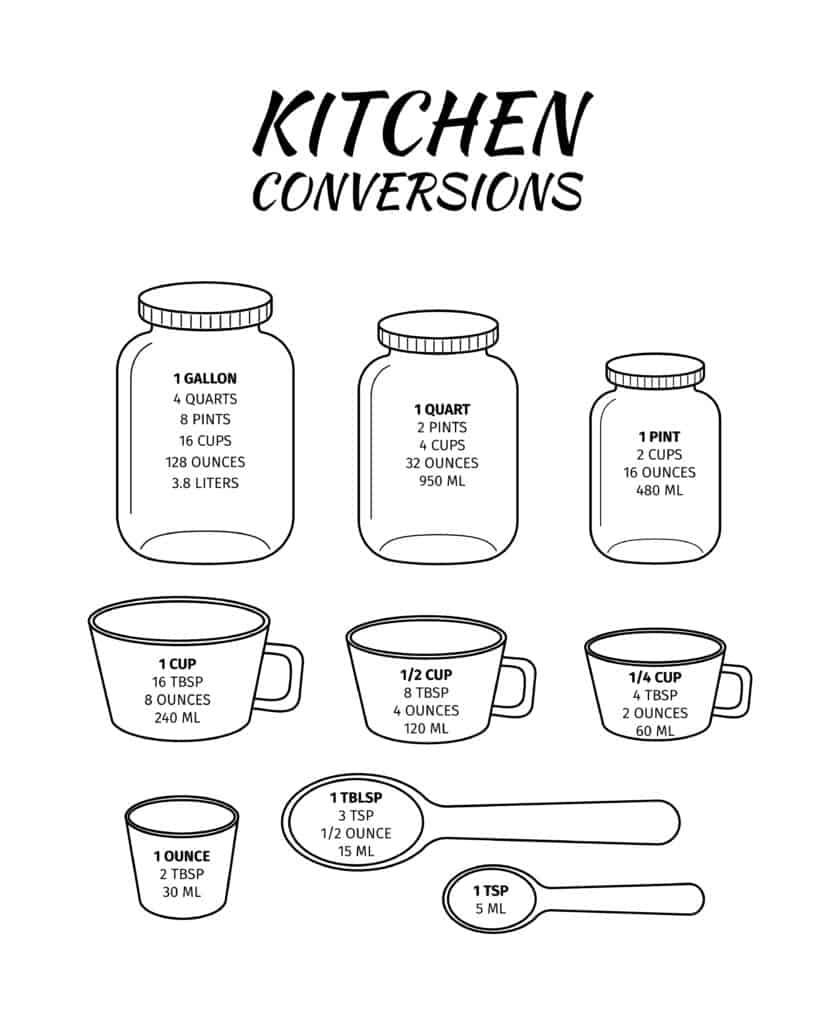Ounces in a Pint: A Quick Guide for Home Cooks
Accelerate your culinary journey by mastering kitchen measurements and learning how many ounces are in a pint to perfect your recipes precisely and efficiently.
Understanding Measurements in the Kitchen
Precise measurements hold a pivotal role in cooking. They balance flavors, distinguishing between a culinary masterpiece and a disaster. Incorrect amounts can lead to taste inconsistencies, unpredictable outcomes, or even wasted ingredients.
Mastering accurate measurements in the kitchen elevates your cooking, guarantees flavor consistency, and reduces ingredient wastage.
Common measurement mistakes, such as overpacking dry ingredients or underestimating liquid volumes, can wreak havoc on a recipe.
Constructing a solid understanding of kitchen measurements like ounces and pints can be the first step toward elevating your cooking skills.
Knowing the number of ounces, whether liquid ounces or dry ounces, is essential for recipe accuracy.

Different Types of Ounces
In the culinary realm, ounces can measure volume (fluid ounces) or weight. The former quantifies liquids, with one fluid ounce equating to approximately 29.5735 milliliters. Conversely, the latter pertains to dry ingredients, where one weight ounce equals 28.3495 grams.
The correct measurement in cooking hinges on discerning between the two. For liquids, a liquid measuring cup precisely measures fluid ounces. A digital kitchen scale offering an 'oz' setting for solids ensures an accurate weight-ounce measurement.
Exploring Pints
A little history about pint: its usage traces back to Old French and Middle English. Historically, the pint has been utilized in various fields, including brewing and dairy products, symbolizing many cooking measurements.
The pint continues to hold significant utility in the culinary world, from measuring ingredients for hearty stew to crafting a recipe for homebrewed beer. Its versatility makes the pint an essential tool in any kitchen, regardless of a cook's skill level.
What is a Pint?
In its simplest terms, a pint is a unit of volume used in various measurement systems across the globe. This unit is embraced in metric and imperial systems, but its exact value can bear strikingly different meanings in certain regions.
For example, the difference in measurement between the United Kingdom and the US pints can create quite a stir as they differ. In the United States, a pint equals 16 fluid ounces, offering ample space for your favorite cold brew.
The U.K. pint holds a more significant volume across the Atlantic, standing at 20 fluid ounces. This subtle transatlantic difference can become a significant factor when replicating recipes from various cuisines, calling for special attention to measurement conversions. You read that right. A pint in the UK is an entire 4 additional U.S. fluid ounces than it is in the US system. This might be one of the reasons why an Irish pint (and even a half pint) is so famous.
Terms To Know:
Familiarize yourself with the terms below. They are important words to know if you do a lot of cooking or baking from cookbooks or websites that use a different measuring unit than you typically use.
- Customary Measurement Systems- customary systems of measurement
- British Imperial Ounces
- Unit Of Measurement
- Conversion Tables- the easiest way to make measurement conversions to figure out measures of volume is with a chart showcasing standard conversion numbers.
- US Fluid Pint (Also US Liquid Pint)- American measurements where a pint is 16 ounces equal to two cups of water.
- English Pints
- British Imperial Pint
- Imperial System (Imperial Measurements)- This is used within the Commonwealth countries and the UK. So, imperial gallon, imperial pint, etc.
- Metric System
- Imperial Fluid Ounces
- US Fluid Ounces
- Conversion Factors
- American Pint
- Conversion Factor
- Cubic Centimeters
- Dry Capacity
Introduction to Measuring Units
Grasping the nuances between volume and weight in kitchen measurements is vital. Volume, represented in ounces, cups, pints, and quarts, measures a substance's space. Contrastingly, weight directly measures an ingredient's heaviness, often denoted in ounces or grams.
Conversions may be a stumbling block, especially when dealing with international recipes. A conversion chart becomes indispensable here, allowing one to swap measurement units easily—ounces to grams, cups to milliliters – all simplified by a comprehensive conversion chart.
Precise kitchen measurement is not merely sticking to recipe instructions; it's also a tool for making culinary experiences genuinely global. A conversion chart and understanding volume and weight contribute towards a kitchen endeavor free from the frustrating hiccups of erroneous measurements.

How Many Fluid Ounces in a Pint?
In cooking and baking, a pint equates to 16 fluid ounces. Acknowledging this tidbit not only streamlines your cooking process but also aids in achieving a more precise recipe execution.
Gaining a firm grasp over kitchen conversions can be a game changer. So, remember, when you need to convert from pints to ounces, it's simple—every pint houses 16 fluid ounces.
Converting Pints to Other Units
Understanding how to convert pints into other units is crucial for managing recipes with varying measurement standards. It enables the seamless crafting of delightful dishes while minimizing inconsistencies.
- To translate pints into cups, remember that 1 pint equals 2 cups.
- Converting pints to quarts is straightforward, as 1 quart equals 2 pints.
- To transform pints into gallons, remember that 1 gallon holds 8 pints.
- Pints can also be converted to fluid ounces, with 1 pint comprising 16 fl oz.
Using Pints in Cooking
Employing pints in cooking can uphold both precision and practicality. Pints prove pivotal in portioning ingredients like soups, sauces, or beverages, maintaining a balance between taste and texture.
The pint plays an essential role in the gastronomic scene. It allows for consistency across different recipes and areas, providing a standardized measure that ensures the quality and uniformity of the prepared dishes.
Baking with Pints
Baking by pints opens a whole new world of precise pastry creation. With this traditional unit, ingredients like milk, cream, and stock can be added precisely, ensuring a consistent outcome every time.
Perfectly scaling your recipes requires an understanding of measurements like pints. This holds, especially in baking, where precision in adding wet ingredients can derail or elevate the result.
Baking relies heavily on ratios and proportions. Mastering pints allows you to move beyond simple recipes and explore more complex and rewarding creations. It’s all about perfecting the balance and harmony in your baked goods.
Measuring Liquids in Pints for Cooking
Starting with simple liquids like water or milk before progressing to viscous ones like honey or molasses can hone your skills at measuring pints. Practice makes perfect, and understanding the physical qualities of each ingredient will aid in masterful measurement.
Make sure to use a pint measure for recipes requiring it. Be precise - every drop counts. Pour the liquid to the top of the measure. If you go over, use a clean spatula or knife to remove the excess. Precision is essential for successful cooking.
When converting recipes from other units to pints, be meticulous. A slight miscalculation can have a significant effect on the end result. Similarly, changing a recipe from pint measurement to another unit requires careful calculation to maintain balance and flavor.
Pints for Drinks and Cocktails
Mastering the art of cocktail proportions requires an understanding of pint-to-ounce translations. A pint, roughly equal to 16 fluid ounces, is often used to measure more significant quantities of spirits or mixers in batching cocktails.
Pint-sized mixology involves delving into measurement specifics. The precision provided by using pints and ounces aids in maintaining consistency in your home-brewing or mixology endeavors.
Whether it's a luxurious punch, your homemade beer, or a signature concoction, measuring in pints allows for the right balance in quantity and taste. This measurement prowess can transform you from a home bartender to a mixologist.
Tips for Accurate Measurements
Mastering precise measurements is pivotal for culinary success. For accurate pint and ounce measurements, consider investing in quality, graduated measuring tools and habitually cross-check your conversions.
Establishing precision in your kitchen is essential, especially when converting between pints and ounces. Always cross-reference conversions with reliable sources, and remember that fluid ounces and weight ounces are different measurements.
Use specialized conversion tools or trusted online resources to ensure accurate conversion from pints to ounces. Keep in mind that liquid and dry measurements can have different ounce values.
Choosing the Right Measuring Tools
Scaling your recipes necessitates the identification of reliable measuring tools. From graduated measuring cups for dry ingredients to glass ones for liquids, ensure you opt for equipment specifically calibrated for ounce and pint measurements.
Accuracy in measurements is quintessential, especially in baking. For precise readings on pints and ounces, equipment essentials range from glass measures for larger quantities to small, metallic measuring spoons for intricate flavoring.
Measuring technology has expanded, enhancing accuracy in the kitchen. Digital scale measures can provide precise calculations for pints and ounces, ensuring exact measurements that directly impact the quality of your culinary creations.
Dealing with Odd Quantities
Dealing with unusual pint and ounce quantities can seem daunting, but it needn't be with some clever cooking tips. Embrace the challenge; understand that cooking isn't always about fixed measurements but more about proportions and adjustments.
Tackling tricky measurements often means navigating odd pint and ounce amounts. Don't shy away from recipes that call for non-standard quantities. Instead, focus on the relative ratios, keeping track of the ingredient proportions, and making adjustments when necessary.
Importance of Proper Technique
In the finely calibrated world of culinary arts, proper measuring techniques hold pivotal value. An incorrect measure of an ingredient, like a pint or an ounce, can lead to dishes falling short of their true potential.
Insisting on precision, especially when dealing with pints and ounces, can make all the difference in your recipes. Always pay special attention to technique, ensuring your measures are as accurate as possible and maintaining flavors and consistency.
Converting Recipes to Metric Units
When trying out international recipes, it's common to encounter metric units. Converting pints and ounces to metric measurements will decipher these foreign recipes and add versatility to your cooking skill set. However, be cautious, as conversion is not always a clear-cut process.
- Note that 1 U.S. pint equals approximately 473 milliliters.
- Measure precisely to keep your recipes accurate post-conversion.
- Test, adjust, and note your converted recipes for a personalized international cookbook.
Kitchen Scales
Owning a digital kitchen scale equipped with both US and metric system unit readouts will often save you time. If you have a kitchen scale, there will be no need for conversion between the USCS and the metric system.
For example, you have a fantastic recipe for Nutella cookies, but all the measurements are in the metric system.
Instead of converting each of these amounts into the USCS, I can pull out my kitchen scale. Using my scale, I can measure all kinds of ingredients in grams and liters! While I don't need it to figure out how many cups are in pints and so on, it is helpful in so many ways.
For this reason alone, I believe a kitchen scale to be an excellent investment.



